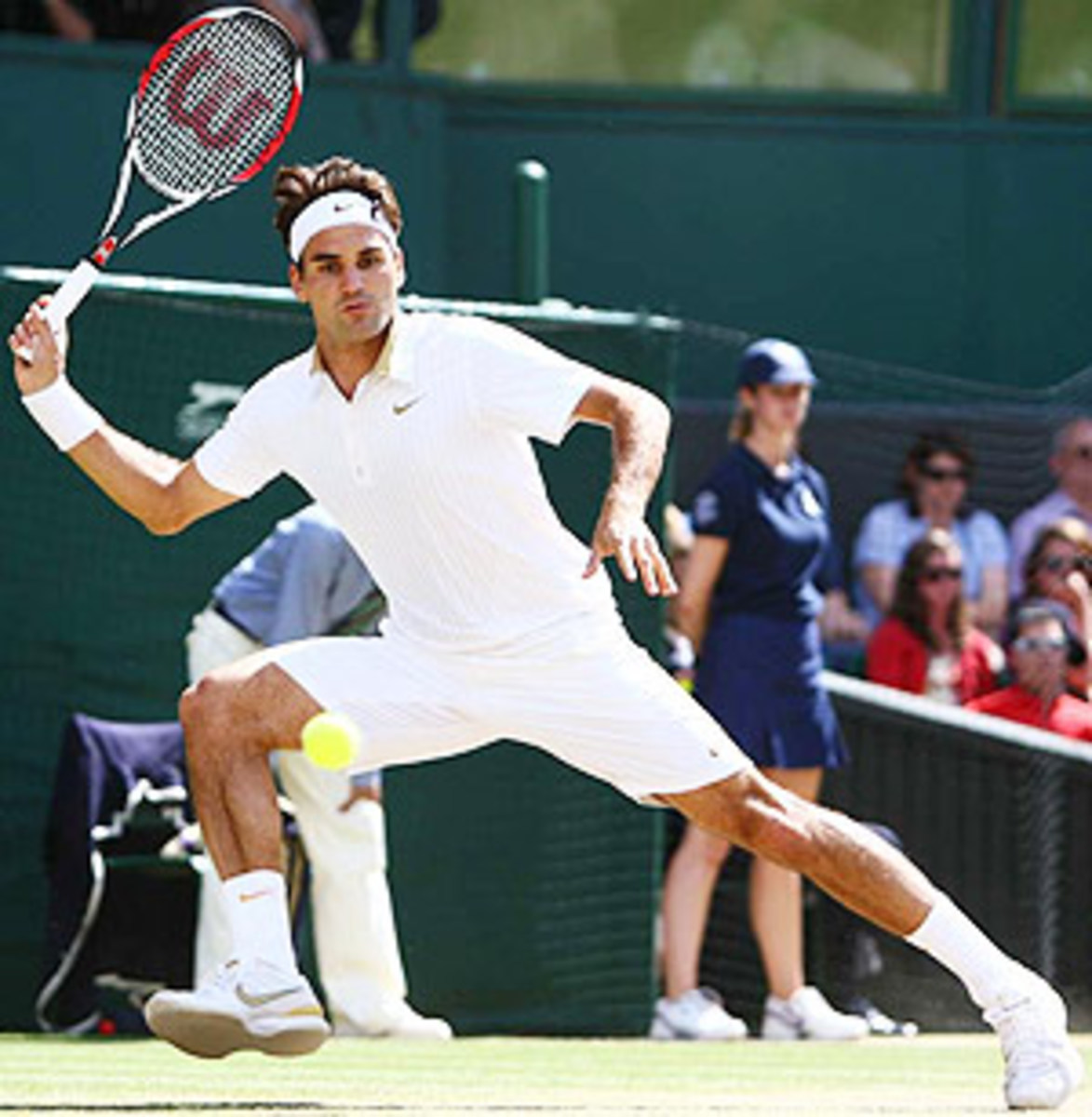Federer draws on inner strength


The Wimbledon grass has always been a bit of a yoga mat for Roger Federer, who routinely moves around Centre Court at mental and physical ease while his more bruiser-like counterparts clip-clop on its blades.
You could see Andy Roddick on Sunday try to channel the one quality that separates Federer from all the rest: elasticity. Unlike anyone else, Federer is able to bend and stretch effortlessly without losing form with a thin body free of excess. Over the past few months, Roddick has made an admirable attempt to replicate Federer's lithe advantage by dropping 15 pounds off his boxcar frame and realizing slim is in.
The muscle on Rafael Nadal and other fitness freaks of the sport serve them well until the pounding of their play breaks down the body. Knees are eroded. Shoulders give way. Muscles tear.
Federer doesn't snap. But as nimble as Roddick was during an epic men's final, as unrelenting as his serve became, Federer's resilient body was equaled by something his opponent could not counter: his indefatigable mind. This uncelebrated asset of Federer's made all the difference in making No. 15 possible with a 5-7, 7-6 (6), 7-6 (5), 3-6, 16-14 Wimbledon title. This art of mental stamina also underscored why one through 14 of his Slam titles happened, too, and why Federer is considered the greatest to ever play tennis.
Think about it: Federer didn't only have to escape a hole in the second-set tiebreaker, he had to emotionally weather the draining effect of watching one Roddick service blast after another either skip past him or bash into his body. "Mentally, it's just getting through games where you never had a chance," Federer said. He did not have one service break of Roddick in the match until the final game of the fifth set.
"You didn't even get the sense that he was even frustrated by [my serve]," Roddick said. "He kind of stayed the course and toughed it out. He gets a lot of credit for a lot of things, but not a lot of the time for how many matches he kind of digs deep and toughs out. He doesn't get a lot of credit for that because it looks easy to him a lot of the times."
Who else but Federer could look as if he'd been pulled fresh from the dryer after 4 hours, 16 minutes and 77 games of a five-set final? Roddick, try as he might to possess Federer's cool, looked dragged from the ocean. And though the effort was valiant in the best match of his life, Roddick couldn't foil the Nike seamstresses and tailors who had stitched a gold "15" into the silky warmup jacket that Federer pulled out of his bag after winning.
Presumptuous or preparedness? The scene seemed a bit too orchestrated. (Roddick, for one, did not look that impressed when Federer sported his "15" jacket about the trophy ceremony.) The party planning was in full force, though. On TV, Nike revved up its congratulatory ad for Federer featuring the stars of the Swoosh family: Serena Williams, Michael Jordan, John McEnroe, Tiger Woods and, yes, Pete Sampras.
Sampras was on site at Wimbledon, seated in the box of legends alongside Rod Laver and Bjorn Borg, to watch Federer pass his all-time Slam record of 14. "Seven years, you let me have it," Sampras said in the Nike ad. "It's tough to swallow." Sampras reappeared at the end of the commercial to say, "Congratulations, Roger. You did it." Sampras didn't arrive at Wimbledon from California until after the match was underway. But Federer saw him -- noticing the stir in the crowd when he was seated -- and gave him a smile and a nod when he walked to the baseline.
"I used to get nervous when a friend would watch me play as a kid," Federer said. "Then it was my parents; then it was legends and people who really meant something. Today, anybody can come and watch me play. I don't get nervous anymore. [But] with Pete, it was a bit special. When he walked in and I saw him for the first time, I did get more nervous actually. I said hello to him, too. I thought I don't want to be rude, you know?"
Grace is a fine social quality but it's also Federer's defining physical and mental weapon. Until Federer materialized as a force in 2003 to soothe the gap left by the Sampras-Andre Agassi generation, no one seemed fit for the tour's No. 1 crown. The top spot was occupied by placeholder players, like Lleyton Hewitt ('01, '02) and Gustavo Kuerten ('00). They were fine players but inconsistently good, OK on one surface but not another. Now wrap your head around all the different threats and various theaters Federer has had to encounter over his 15-Slam spree: Mark Philippoussis ('03 Wimbledon), Marat Safin ('04 Australian Open), Agassi ('05 U.S. Open), Marcos Baghdatis ('06 Australian Open), Nadal ('07 Wimbledon), Andy Murray ('08 U.S. Open) and Robin Soderling ('09 French Open).
Federer had beaten Roddick in the Wimbledon finals in '04 and '05, but he had not faced this version 2.0 of Roddick -- slimmer, more agile, ever powerful. But Federer did what he has done throughout his splendid career: He simply outlasted an opponent, as much mentally as physically, on his favorite patch of grass.
"I'm happy I broke the record here," Federer said. "This is always a tournament that has meant the most to me -- my heroes and idols being so successful here. It feels like it's come full circle, starting it here and ending it here. [But] my career is far from over."
How many major titles will Federer be holding at the end? Maybe 18? Even 20 titles don't seem like a stretch. Federer's greatness is elastic, too.
